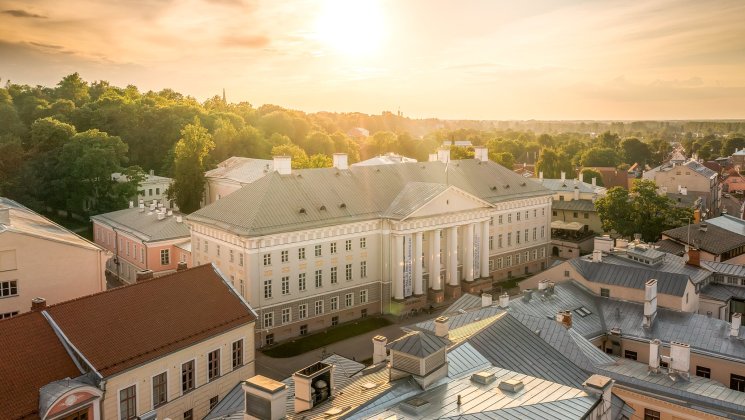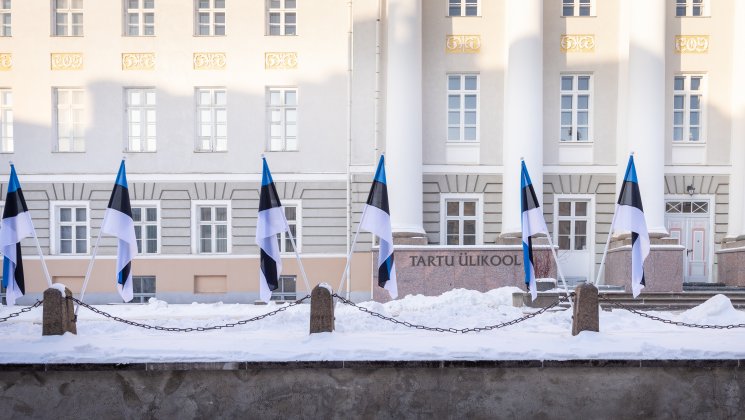-
Faculty of Arts and HumanitiesDean's Office, Faculty of Arts and HumanitiesJakobi 2, r 116-121 51005 Tartu linn, Tartu linn, Tartumaa EST0Institute of History and ArchaeologyJakobi 2 51005 Tartu linn, Tartu linn, Tartumaa EST0Institute of Estonian and General LinguisticsJakobi 2, IV korrus 51005 Tartu linn, Tartu linn, Tartumaa ESTInstitute of Philosophy and SemioticsJakobi 2, III korrus, ruumid 302-337 51005 Tartu linn, Tartu linn, Tartumaa EST0Institute of Cultural ResearchÜlikooli 16 51003 Tartu linn, Tartu linn, Tartumaa EST0Institute of Foreign Languages and CulturesLossi 3 51003 Tartu linn, Tartu linn, Tartumaa EST0School of Theology and Religious StudiesÜlikooli 18 50090 Tartu linn, Tartu linn, Tartumaa EST0Viljandi Culture AcademyPosti 1 71004 Viljandi linn, Viljandimaa EST0Professors emeritus, Faculty of Arts and Humanities0Associate Professors emeritus, Faculty of Arts and Humanities0Faculty of Social SciencesDean's Office, Faculty of Social SciencesLossi 36 51003 Tartu linn, Tartu linn, Tartumaa EST0Institute of EducationJakobi 5 51005 Tartu linn, Tartu linn, Tartumaa EST0Johan Skytte Institute of Political StudiesLossi 36, ruum 301 51003 Tartu linn, Tartu linn, Tartumaa EST0School of Economics and Business AdministrationNarva mnt 18 51009 Tartu linn, Tartu linn, Tartumaa EST0Institute of PsychologyNäituse 2 50409 Tartu linn, Tartu linn, Tartumaa EST0School of LawNäituse 20 - 324 50409 Tartu linn, Tartu linn, Tartumaa EST0Institute of Social StudiesLossi 36 51003 Tartu linn, Tartu linn, Tartumaa EST0Narva CollegeRaekoja plats 2 20307 Narva linn, Ida-Virumaa EST0Pärnu CollegeRingi 35 80012 Pärnu linn, Pärnu linn, Pärnumaa EST0Professors emeritus, Faculty of Social Sciences0associate Professors emeritus, Faculty of Social Sciences0Faculty of MedicineDean's Office, Faculty of MedicineRavila 19 50411 Tartu linn, Tartu linn, Tartumaa ESTInstitute of Biomedicine and Translational MedicineBiomeedikum, Ravila 19 50411 Tartu linn, Tartu linn, Tartumaa ESTInstitute of PharmacyNooruse 1 50411 Tartu linn, Tartu linn, Tartumaa ESTInstitute of DentistryL. Puusepa 1a 50406 Tartu linn, Tartu linn, Tartumaa ESTInstitute of Clinical MedicineL. Puusepa 8 50406 Tartu linn, Tartu linn, Tartumaa ESTInstitute of Family Medicine and Public HealthRavila 19 50411 Tartu linn, Tartu linn, Tartumaa ESTInstitute of Sport Sciences and PhysiotherapyUjula 4 51008 Tartu linn, Tartu linn, Tartumaa ESTprofessors emeritus, Faculty of Medicine0associate Professors emeritus, Faculty of Medicine0Faculty of Science and TechnologyDean's Office, Faculty of Science and TechnologyVanemuise 46 - 208 51003 Tartu linn, Tartu linn, Tartumaa ESTInstitute of Computer ScienceNarva mnt 18 51009 Tartu linn, Tartu linn, Tartumaa ESTInstitute of GenomicsRiia 23b/2 51010 Tartu linn, Tartu linn, Tartumaa ESTEstonian Marine Institute0Institute of PhysicsInstitute of ChemistryRavila 14a 50411 Tartu linn, Tartu linn, Tartumaa ESTInstitute of Mathematics and StatisticsNarva mnt 18 51009 Tartu linn, Tartu linn, Tartumaa EST0Institute of Molecular and Cell BiologyRiia 23, 23b - 134 51010 Tartu linn, Tartu linn, Tartumaa ESTTartu ObservatoryObservatooriumi 1 61602 Tõravere alevik, Nõo vald, Tartumaa EST0Institute of TechnologyNooruse 1 50411 Tartu linn, Tartu linn, Tartumaa ESTInstitute of Ecology and Earth SciencesJ. Liivi tn 2 50409 Tartu linn, Tartu linn, Tartumaa ESTprofessors emeritus, Faculty of Science and Technology0associate Professors emeritus, Faculty of Science and Technology0Area of Academic SecretaryHuman Resources OfficeÜlikooli 18, ruumid 302 ja 304 50090 Tartu linn, Tartu linn, Tartumaa EST0Area of Head of FinanceFinance Office0Area of Director of AdministrationInformation Technology Office0Administrative OfficeÜlikooli 17 (III korrus) 51005 Tartu linn, Tartu linn, Tartumaa EST0Estates Office0Marketing and Communication OfficeÜlikooli 18, ruumid 102, 104, 209, 210 50090 Tartu linn, Tartu linn, Tartumaa EST0Area of Vice Rector for Academic AffairsOffice of Academic AffairsUniversity of Tartu Youth AcademyUppsala 10 51003 Tartu linn, Tartu linn, Tartumaa ESTStudent Union OfficeÜlikooli 18b 51005 Tartu linn, Tartu linn, Tartumaa EST0Centre for Learning and TeachingArea of Vice Rector for ResearchUniversity of Tartu LibraryW. Struve 1 50091 Tartu linn, Tartu linn, Tartumaa ESTGrant OfficeArea of Vice Rector for DevelopmentCentre for Entrepreneurship and InnovationNarva mnt 18 51009 Tartu linn, Tartu linn, Tartumaa EST0University of Tartu Natural History Museum and Botanical GardenVanemuise 46 51003 Tartu linn, Tartu linn, Tartumaa EST0International Cooperation and Protocol Office0University of Tartu MuseumLossi 25 51003 Tartu linn, Tartu linn, Tartumaa EST0Area of RectorRector's Strategy OfficeInternal Audit Office
The University of Tartu Museum will celebrate the 250th anniversary of Johann Karl Simon Morgenstern’s birth with two new exhibitions
Photo of the exhibition "The enchanging art of stone cutting. Morgernstern 250", photo credit to Piret Tamm
This year marks 250 years from the birth of Johann Karl Simon Morgenstern, founder of the University of Tartu Art Museum, long-time director of the university library and professor of rhetoric, classical philology, aesthetics, literary and art history. To celebrate the anniversary of the birth of the professor who spent 50 years of his life in Tartu, an exhibition titled “The enchanting art of stone cutting. Morgenstern 250” will be opened at the University of Tartu Art Museum on 11 June, and the exhibition “Morning Star” will be launched the same day in the garden of the Old Observatory.
An art museum was established at the University of Tartu in 1803 at the initiative of Johann Karl Simon Morgenstern to illustrate lectures and develop the aesthetic taste of the students. For this purpose, the museum collected prints, paintings, drawings, ancient Egyptian and eastern artefacts, ancient Greek and Roman coins and ceramics. In terms of volume, out of any other items Morgenstern bought the most of plaster casts of ancient gems, which provide an inexhaustible source of images about the antiquity. The new exhibition takes a closer look at the now forgotten art of stone cutting.
The exhibition has a visitor program. In September, lectures and workshops connected to the exhibition will begin—Wednesday evenings will be dedicated to discussing many topics from geology to Estonian jewellery. It is mostly held in Estonian but in case of interest see for more here
The curator of the exhibition is Jaanika Anderson, the University of Tartu Museum’s Director of Research, it is designed by Mari Kurismaa and the graphic solution was authored by Mari Kaljuste. The exhibition is in Estonian and English and is supported by the Cultural Endowment of Estonia. The exhibition is available until 26 March 2021.
The German word Morgenstern means the morning star, a sobriquet of the planet Venus. The entire life of Professor Morgenstern was dedicated to classical antiquity and the fine arts, and the ancient Roman goddess of beauty Venus must therefore have been close to his heart. The exhibition at the Old Observatory’s garden introduces the planet of Venus, the story of studying it and the role Johann Heinrich Mädler and Ernst Julius Öpik, astronomers who worked at the observatory, had in this.
The exhibition was prepared by Lea Leppik, curator of the University of Tartu Museum, Regina Pala, curator of Educational Programs, and Jaak Jaaniste, an astronomer. The exhibition was designed by Maarja Roosi from the University of Tartu Press, and the graphic design’s authors are Maarja Roosi and Marge Nelk from the University of Tartu Museum. The exhibition is in Estonian and is available free of charge at the Old Observatory’s garden. It will remain open at least until the end of the year.
Additional information:
Jaanika Anderson, Director of Research of the University of Tartu Museum, jaanika.anderson@ut.ee, 5344 7404
Lea Leppik, Curator of the University of Tartu Museum, lea.leppik@ut.ee, 526 1236

Preparation of the university's new strategic plan begins

